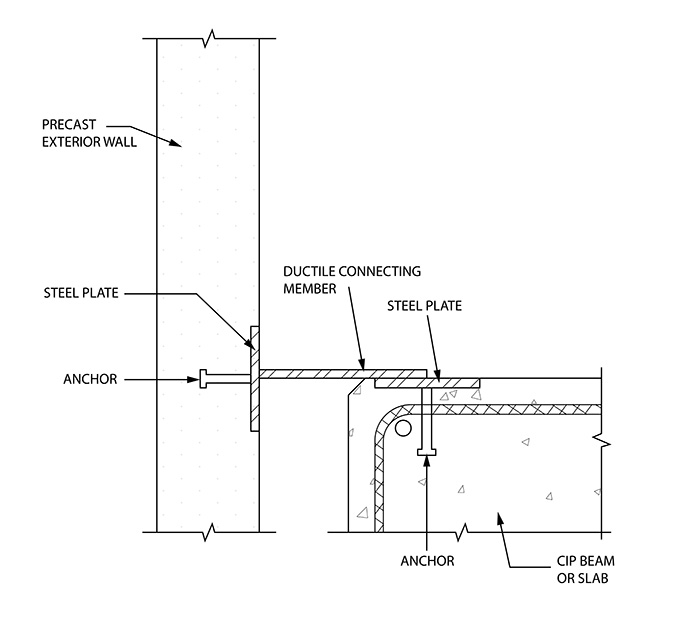
Seismic Design of Architectural Precast Concrete Connections per ASCE/SEI 7-16
Architectural precast concrete (or nonstructural wall panels) are frequently connected to the superstructure as part of the exterior building envelope. For seismic applications, ASCE 7-16 Section 13.5.3 requires that the fasteners of the connecting system be able to resist a little over three times the seismic forces compared to those required for the body of the connecting member. At the same time, the body of the connecting member is required to exhibit ductile behavior under seismic loading. Below is a Q/A to clarify some of these requirements.
Q. While designing precast concrete external cladding connections, ASCE 7-16 Table 13.5-1 assigns ap and Rp values of 1.0 and 2.5, respectively, to the “body of wall panel connections” while assigning ap and Rp values of 1.25 and 1.0, respectively, to the “fasteners of the connecting system”. As a result, the fasteners are being designed for a little more than 3 times the seismic forces required for the body of the connecting member. In addition, Section 13.5.3 item 3 requires the connecting member itself to have sufficient ductility to preclude a brittle failure. My questions are:
- Why are the fasteners being designed for so much more seismic force compared to the body of the connecting member?
- Since the fastener anchorage is required to be designed in accordance with ACI 318-14 Chapter 17, are the anchors deemed to comply with the requirements of Section 17.2.3.4.3(d) of ACI 318-14 due to their higher design forces mentioned above?
- If the answer to Question 2 is “yes”, then why do I need to additionally ensure ductile behavior in the body of the connecting member? Per ACI 318-14 if you meet Section 17.2.3.4.3(d) you don’t have to prove a ductile failure mechanism so why does ASCE 7-16 Section 13.5.3 Item 3 require a ductile failure?
A. When designing external cladding it is important to not only design for the anticipated gravity, wind, and seismic (inertial) forces but also the anticipated movement of the structure resulting from lateral forces and temperature change. That is, under seismic loading, the structure will most likely impose a displacement on the connection. The connection will need to accommodate this displacement either through a sliding mechanism using slotted or oversized holes or through bending of connecting members. Failure to do so could result in the cladding dislodging from the structure and cause significant damage to property or loss of life. With this in mind, below are the answers to your questions:
- The idea behind setting a comparatively high design force for the fasteners is so that the connection isn’t governed by brittle anchorage failure and that if failure were to occur it would occur in the body of the connection between the wall component and the superstructure. Designing the fasteners for amplified forces ensures they remain essentially elastic under design seismic forces. To achieve this intent, the tabulated ap and Rp values produce fastener design forces that are a little over three times those for the connecting members.
- Yes, Section 17.2.3.4.3(d) of ACI 318-14 allows the option of designing the anchor for the seismic force, E, increased by Ωo. Per ASCE 7 Table 13.5-1, fasteners of the connection system have an Ωo equal to 1.0. Thus, satisfying option (d) of Section 17.2.3.4.3 is achieved automatically.
- Because the external cladding also needs to accommodate the story drift resulting of the structure, amplifying the fastener forces in and of itself is not adequate; there must be a yielding or sliding element somewhere in the load path. This is what ASCE 7-16 Section 13.5.3 Item 3 refers to as “sufficient ductility and rotation capacity” for the body of the connecting member. This requirement is not for the anchorage of the connection, and as a result, amplified anchorage forces do not preclude this requirement.
Support for responding to this Q/A was provided by Mr. John Silva, S.E., of Hilti North America.